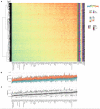A Comprehensive View on the Human Antibody Repertoire Against Staphylococcus aureus Antigens in the General Population
- PMID: 33777051
- PMCID: PMC7987813
- DOI: 10.3389/fimmu.2021.651619
A Comprehensive View on the Human Antibody Repertoire Against Staphylococcus aureus Antigens in the General Population
Abstract
Our goal was to provide a comprehensive overview of the antibody response to Staphylococcus aureus antigens in the general population as a basis for defining disease-specific profiles and diagnostic signatures. We tested the specific IgG and IgA responses to 79 staphylococcal antigens in 996 individuals from the population-based Study of Health in Pomerania. Using a dilution-based multiplex suspension array, we extended the dynamic range of specific antibody detection to seven orders of magnitude, allowing the precise quantification of high and low abundant antibody specificities in the same sample. The observed IgG and IgA antibody responses were highly heterogeneous with differences between individuals as well as between bacterial antigens that spanned several orders of magnitude. Some antigens elicited significantly more IgG than IgA and vice versa. We confirmed a strong influence of colonization on the antibody response and quantified the influence of sex, smoking, age, body mass index, and serum glucose on anti-staphylococcal IgG and IgA. However, all host parameters tested explain only a small part of the extensive variability in individual response to the different antigens of S. aureus.
Keywords: S. aureus; anti-S. aureus IgA response; anti-S. aureus IgG response; antibody repertoire; host-pathogen-interaction; immunoproteomics.
Copyright © 2021 Meyer, Michalik, Holtfreter, Weiss, Friedrich, Völzke, Kocher, Kohler, Schmidt, Bröker and Völker.
Conflict of interest statement
The authors declare that the research was conducted in the absence of any commercial or financial relationships that could be construed as a potential conflict of interest.
Figures








References
-
- Gagliotti C, Balode A, Baquero F, Degener J, Grundmann H, Gür D, et al. . Escherichia coli and Staphylococcus aureus: bad news and good news from the European Antimicrobial Resistance Surveillance Network (EARS-Net, formerly EARSS), 2002 to (2009). Euro Surveillance. (2011) 16:19819. 10.2807/ese.16.11.19819-en - DOI - PubMed
Publication types
MeSH terms
Substances
LinkOut - more resources
Full Text Sources
Other Literature Sources
Medical
Molecular Biology Databases
Miscellaneous

